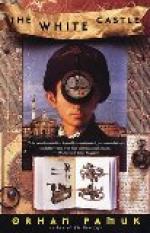|
This section contains 872 words (approx. 3 pages at 400 words per page) |

|
The White Castle
The white castle represents an ideal, such as Hoja's Truth, Plato's Forms, or Kant's “Ding an sich” (thing in itself). It does not exist in real life, except as a pure concept. “It was at the top of a high hill, its towers streaming with flags were caught by the faint red glow of the setting sun, and it was white; purest white and beautiful” (143). The narrator writes that he knew “that our soldiers would never be able to reach the white towers of the castle” (143). Doppio (“double” in Italian) Castle, like Don Quixote's ideal, is unattainable.
The Black Stain
The stain is probably a blotch of black ink, but the narrator calls the black stain the "devil" of the drawing. In the Faust legend, Faust makes a pact with the Devil, wherein Faust has his wishes fulfilled for 24 years, at which time the...
|
This section contains 872 words (approx. 3 pages at 400 words per page) |

|




